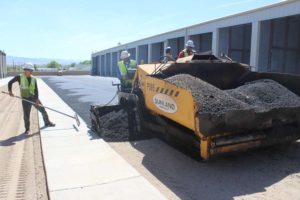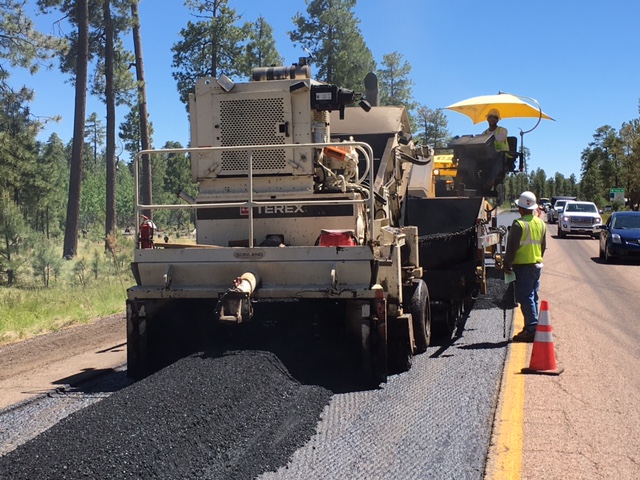
People drive and walk on asphalt everyday without even thinking about it. Asphalt pavement covers roads, runways and parking lots so that people can get where they need to go all over the world. It’s one of the most commonly used pavement materials because it is tough, can be repaired quickly and can be recycled into other pavement projects.
What Ingredients Go Into Asphalt Pavement?
The two main ingredients mixed together to make asphalt pavement are asphalt cement and aggregate. Asphalt cement is a highly viscous liquid form of petroleum. It acts as the glue that binds the aggregate (small rocks) together to create a tough and flexible material. Asphalt pavement is usually composed of 5% asphalt cement and 95% aggregate. Typically, in the lower levels of a pavement layer, aggregate particles are larger and slightly less angular; in the surface levels, the particles are smaller and more angular. Very small aggregate particles called “fines” may be mixed in to extend the life of the pavement. In additional to asphalt cement and aggregate, manufacturing companies might add certain chemicals to the mixture such as hydrated lime for a tighter bond, or polymers for improved flexibility. Ingredients may vary somewhat depending on the climate of the location the asphalt pavement is to be applied. Asphalt for warmer climate sites is made harder for withstanding hotter temperatures, and asphalt for colder climate sites is made softer.
How Is the Asphalt Pavement Mixture Made?
Asphalt pavement mixtures are typically manufactured at a plant. All ingredients must be precisely measured to suit the type of project and the climate of the project site. Then, the thick asphalt cement must be made thinner in order to be able to mix it with aggregate and other components. Methods for thinning the asphalt include dilution by applying a solvent, emulsification in water or application of heat. Heating is the most common method. Aggregate must be cleaned, dried and heated. When both the aggregate and the asphalt have been raised to the correct temperature, they are blended together in either a drum or pugmill, which are different types of mixing machines that produce a homogeneous mixture. Choosing the correct temperatures for the process is crucial – manufacturers must adjust temperatures based on the time it will take to transport the pavement mixture from the plant to the construction site, how thick the asphalt cement is to start with and how long it will take to compact the mixture once applied.

What’s the Difference Between Hot Mix Asphalt and Warm Mix Asphalt?
Hot mix asphalt is currently the most commonly used form of asphalt pavement, but warm mix asphalt is being increasingly used for construction projects. HMA requires that aggregate be dried and heated and asphalt cement be heated to a very high temperature before mixing the two. Furthermore, HMA must be maintained at high temperatures while it is being applied and compacted. To make WMA, certain emulsions, zeolites, waxes or water are added to the asphalt cement before it is mixed with the aggregate. This technique allows for production at much lower temperatures, which reduces energy consumption, petroleum use and emissions of harmful gasses.
The manufacturing of asphalt is a varied yet precise process. When applied by trained professionals and properly maintained, it can last for decades.



